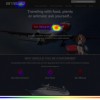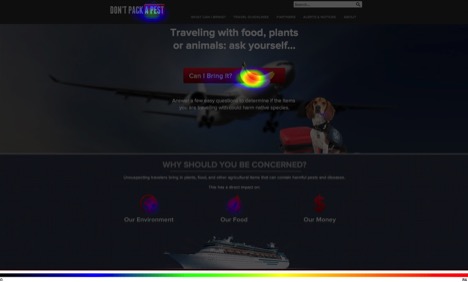Knowing how to create and design a website is a valuable skill. This four-part series explains general tenants of good web design, covers the terminology and techniques involved in creating appealing, user-friendly websites, and also discusses basic HTML coding and developing visual elements for the web. Written by Ricky Telg, Laura Gorham, and Tracy Irani, and published by the UF Department of Agricultural Education and Communication, August 2015.
http://edis.ifas.ufl.edu/topic_series_writing_and_designing_for_the_web
Tag: Laura Gorham
Using Heat Maps to Determine the Usability of Extension Communication Materials
 This heat map from a website usability test shows that more people click on the banana image than anywhere else on the computer screen, followed by the button at the top of the screenshot. This tool allows Extension faculty to determine the ease of respondent use of the communication material. This 6-page fact sheet explains how to use heat maps and how to develop heat map questions in Qualtrics. Written by Laura M. Gorham, Shuyang Qu, Ricky Telg, and Alexa Lamm, and published by the UF Department of Agricultural Education and Communication, February 2015.
This heat map from a website usability test shows that more people click on the banana image than anywhere else on the computer screen, followed by the button at the top of the screenshot. This tool allows Extension faculty to determine the ease of respondent use of the communication material. This 6-page fact sheet explains how to use heat maps and how to develop heat map questions in Qualtrics. Written by Laura M. Gorham, Shuyang Qu, Ricky Telg, and Alexa Lamm, and published by the UF Department of Agricultural Education and Communication, February 2015.
http://edis.ifas.ufl.edu/wc198
Floridians' Perceptions of GMOs: GMOs and Florida Citrus
 Worldwide and in Florida, food-related issues such as food safety, food security, and use of new food technologies continue to be top concerns. Among the food-related issues are concerns about consuming the products from transgenic plants, often referred to as “GMOs.” This 4-page fact sheet is intended to help Extension faculty understand public perceptions regarding the use of genetic engineering to combat citrus greening. Extension faculty can use this understanding of public perceptions as they develop and deliver programming for clientele. Written by Nicole M. W. Dodds, Laura M. Gorham, and Joy N. Rumble, and published by the UF Department of Agricultural Education and Communication, October 2014.
Worldwide and in Florida, food-related issues such as food safety, food security, and use of new food technologies continue to be top concerns. Among the food-related issues are concerns about consuming the products from transgenic plants, often referred to as “GMOs.” This 4-page fact sheet is intended to help Extension faculty understand public perceptions regarding the use of genetic engineering to combat citrus greening. Extension faculty can use this understanding of public perceptions as they develop and deliver programming for clientele. Written by Nicole M. W. Dodds, Laura M. Gorham, and Joy N. Rumble, and published by the UF Department of Agricultural Education and Communication, October 2014.
http://edis.ifas.ufl.edu/wc182
Persuasion in Messages
 Specific contextual cues are added to media messages that persuade people to think one way or another about an issue and influence their actions. In this publication, you will learn the different ways that the mass media use persuasion and how persuasion encourages the audience to change their attitudes or behavior. This 3-page fact sheet was written by Laura Gorham, Ricky Telg, and Tracy Irani, and published by the UF Department of Agricultural Education and Communication, July 2013.
Specific contextual cues are added to media messages that persuade people to think one way or another about an issue and influence their actions. In this publication, you will learn the different ways that the mass media use persuasion and how persuasion encourages the audience to change their attitudes or behavior. This 3-page fact sheet was written by Laura Gorham, Ricky Telg, and Tracy Irani, and published by the UF Department of Agricultural Education and Communication, July 2013.
http://edis.ifas.ufl.edu/wc145
Persuasive Papers, Speeches, and Campaigns
 Persuasion can be used in written essays, speeches or as part of media campaigns that attempt to influence an audience to change their thinking or behavior. This publication will familiarize you with the tools necessary to develop a persuasive essay, speech, or media campaign. This 3-page fact sheet was written by Laura Gorham, Ricky Telg, and Tracy Irani, and published by the UF Department of Agricultural Education and Communication, July 2013.
Persuasion can be used in written essays, speeches or as part of media campaigns that attempt to influence an audience to change their thinking or behavior. This publication will familiarize you with the tools necessary to develop a persuasive essay, speech, or media campaign. This 3-page fact sheet was written by Laura Gorham, Ricky Telg, and Tracy Irani, and published by the UF Department of Agricultural Education and Communication, July 2013.
http://edis.ifas.ufl.edu/wc146

